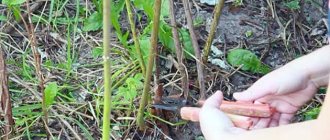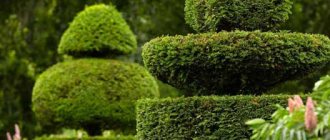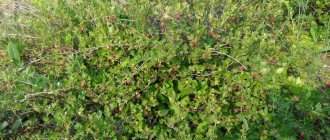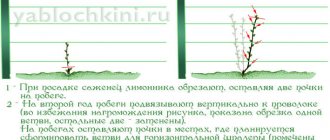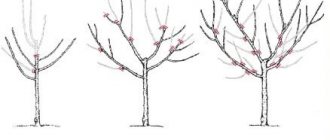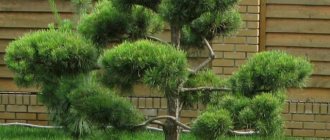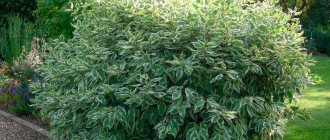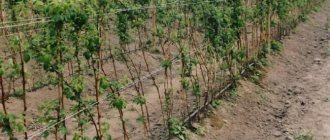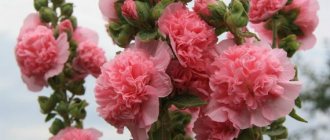Meaning of the procedure
Hawthorn is an unpretentious plant to care for, so even a beginner in gardening can cope with it. But everyone needs to know that this bush needs regular, timely pruning. The significance of this operation is undeniable.
- If this is not done, the bush will grow and take on a sloppy, unkempt appearance.
- Timely formation of the crown stimulates the emergence of new young shoots.
- A tree that is properly cared for will have more fruit.
Therefore, you should not rely on the power of nature - it is better to prune and regulate the condition of the bush on your own.
Deadlines
Depending on the purpose of pruning the bush, it can be done at different times of the year.
- In the spring, the procedure of forming the crown is most often carried out, making it decorative and neat. The optimal period is the end of the first spring month and the beginning of the second, at which time the hawthorn has not yet woken up. The air temperature should be above zero.
- In autumn, pruning is carried out to remove old dead branches and diseased shoots. This will help prepare the plant for winter and kill pests.
After the procedure, it is not recommended to treat the wounds; natural healing is preferable for hawthorn.
Varieties
Experts advise pruning the hawthorn bush twice a year, and if for some reason this is impossible, be sure to keep the spring procedure - you can do without the autumn one.
It is customary to distinguish the following types of pruning.
- Rejuvenating. Helps accelerate the growth of young shoots. It consists of removing old branches of a tree or bush - this will cause further growth of young shoots, renewal of the crown and an increase in the yield and quality of the fruit.
- Regulatory. Allows you to update fruit branches.
- Sanitary. Removing branches affected by diseases or pests. It is also carried out when dry or rotten branches appear. It is considered mandatory, otherwise the plant may die.
- Restorative. Helps if the plant is frozen.
- Thinning. This involves removing branches inside the crown and dry branches.
- Decorative. The plant makes it possible to form a crown in the shape of a ball or a pyramid, so the owner can afford to experiment in the field of landscape design.
To increase the yield of a plant, it is customary to prune growing branches.
If the plant is used as a hedge, it must be severely pruned - no more than 1/3 of each shoot remains. Such bushes are pruned in the last weeks of spring and in the second half of summer.
Rules
In order to maintain the beautiful shape of the bush during the pruning process, it is recommended to adhere to the following tips.
- Leave the plant with 5 to 7 main branches.
- Their height should be within 2 meters.
- In the first year, all shoots are pruned at a height of 15 cm from the ground.
- In the summer of the second year, you can slightly shorten the side branches, this will cause rapid growth of the plant. And in early spring they are removed almost to the ground (about 2 cm will be enough).
- The main branches should be cut back by about ½. It is also recommended to do this in the spring. In summer, these branches are slightly trimmed.
- In the third year, you should correct the shape of the formed bush using pruning shears and maintain it throughout the season.
Reproduction
Hawthorn is propagated in any convenient way - using seeds, layering, grafting or root suckers. It is worth considering that the seeds of this plant germinate very slowly; in some varieties they may sprout only after a year. Planting with seeds is recommended only for ordinary plant forms common in central Russia.
Decorative forms of the plant will look appropriate in the form of grafting onto a trunk up to 1.5 m high.
To grow certain varieties of hawthorn on a plot, it is necessary to graft them onto rowan or blood-red hawthorn seedlings. Planting by seed can lead to loss of their varietal properties. It is best to plant cuttings during sap flow, in early spring. This is done by budding into a T-shaped incision. Such plants will begin to bear fruit within two years.
Cuttings from green parts of a plant are used very rarely, since such planting material takes root very poorly.
It is quite easy to propagate a plant from root cuttings. To do this, you need to dig up the hawthorn rhizomes in the fall, free them from the ground and cut them into pieces of about 10 cm. Roots 20 cm thick are best suited for this. The resulting cuttings are buried in the hole with the thick side up at a slight angle. They need to be buried to a depth of 2 cm. Planting should be done in a greenhouse. The cuttings need careful care - the soil in which they are buried should not dry out. The cuttings can be transplanted into open ground in early spring.
Plant propagation by layering is very popular. This method is possible if there is already a full-fledged bush on the site. So, its lower side branches must be completely or partially laid under the ground and covered with soil. Such shoots take root well and quickly.
A large number of seedlings can be obtained using vertical layering. To do this, the lower part of the bush is covered with soil up to the branch distribution mark. After some time, each of the branches covered with earth will take root and can be separated.
Principles of pruning for hedges
Hawthorn is not only a useful plant with tasty fruits, but also an interesting element of landscape design. In particular, its use as a hedge is very popular. But for such a fence to look good, trimming will also be required, which can be of two options:
With free form, it is extremely important to pinch the shoots at the beginning of development, since if this is not done, the plants will tend to rise upward, turning into unattractive sticks. And timely pruning in early spring (before the buds appear) will cause the bush to acquire side branches and take on a more decorative shape.
To form a hedge, 1 or 2 shoots should be left; this is done in the second year after planting the seedling. After this, the shoots will intertwine with each other, creating a hedge. At this stage, the owner only needs to monitor - when the “fence” reaches the required length and width, it is trimmed to maintain the selected formats.
If the plant has a high growth rate, it can be cut 2-3 times per season, but the last procedure should be carried out no later than the second week of July. The growth is cut to approximately ½ or 2/3 of the length.
To determine how to remove shoots, you need to focus on lateral branching: the branches should be approximately equal in length so that it is more convenient for them to grow, creating a dense hedge. And in the place of the fence where you plan to create a passage, you can place a board during pruning and use it to guide the length of the branches.
Pruning hawthorn is not difficult, but it is important to remember that the plant is very thorny, so care should be taken when working with it.
Hawthorn is a multi-stemmed, spreading shrub. Both ornamental and fruit crops are grown in garden plots. For good growth and development, the plant requires certain care: in particular, pruning hawthorn in the fall. Without pruning, the crown will grow, and the bush will receive less fresh air and sunlight.
Pruning hawthorn in autumn video
Among the popular garden plants with tasty and healthy fruits is the hawthorn, which can increasingly be found in summer cottages. However, the plant should be well looked after, and pruning a hawthorn bush in spring and autumn raises questions for beginning gardeners.
Meaning of the procedure
Hawthorn is an unpretentious plant to care for, so even a beginner in gardening can cope with it. But everyone needs to know that this bush needs regular, timely pruning. The significance of this operation is undeniable.
- If this is not done, the bush will grow and take on a sloppy, unkempt appearance.
- Timely formation of the crown stimulates the emergence of new young shoots.
- A tree that is properly cared for will have more fruit.
Therefore, you should not rely on the power of nature - it is better to prune and regulate the condition of the bush on your own.
Deadlines
Depending on the purpose of pruning the bush, it can be done at different times of the year.
- In the spring, the procedure of forming the crown is most often carried out, making it decorative and neat. The optimal period is the end of the first spring month and the beginning of the second, at which time the hawthorn has not yet woken up. The air temperature should be above zero.
- In autumn, pruning is carried out to remove old dead branches and diseased shoots. This will help prepare the plant for winter and kill pests.
After the procedure, it is not recommended to treat the wounds; natural healing is preferable for hawthorn.
Varieties
Experts advise pruning the hawthorn bush twice a year, and if for some reason this is impossible, be sure to keep the spring procedure - you can do without the autumn one.
It is customary to distinguish the following types of pruning.
- Rejuvenating. Helps accelerate the growth of young shoots. It consists of removing old branches of a tree or bush - this will cause further growth of young shoots, renewal of the crown and an increase in the yield and quality of the fruit.
- Regulatory. Allows you to update fruit branches.
- Sanitary. Removing branches affected by diseases or pests. It is also carried out when dry or rotten branches appear. It is considered mandatory, otherwise the plant may die.
- Restorative. Helps if the plant is frozen.
- Thinning. This involves removing branches inside the crown and dry branches.
- Decorative. The plant makes it possible to form a crown in the shape of a ball or a pyramid, so the owner can afford to experiment in the field of landscape design.
To increase the yield of a plant, it is customary to prune growing branches.
If the plant is used as a hedge, it must be severely pruned - no more than 1/3 of each shoot remains. Such bushes are pruned in the last weeks of spring and in the second half of summer.
Rules
In order to maintain the beautiful shape of the bush during the pruning process, it is recommended to adhere to the following tips.
- Leave the plant with 5 to 7 main branches.
- Their height should be within 2 meters.
- In the first year, all shoots are pruned at a height of 15 cm from the ground.
- In the summer of the second year, you can slightly shorten the side branches, this will cause rapid growth of the plant. And in early spring they are removed almost to the ground (about 2 cm will be enough).
- The main branches should be cut back by about ½. It is also recommended to do this in the spring. In summer, these branches are slightly trimmed.
- In the third year, you should correct the shape of the formed bush using pruning shears and maintain it throughout the season.
This way you can give the bush the desired appearance. However, when pruning the plant, it is important to ensure that its lower part is not left bare and is also covered with branches. Only in this case can you get a uniformly lush crown.
Which branches need to be deleted?
- Wild shoots.
- Broken.
- Sick or dry.
- Unnecessarily long.
- Crossed.
Interestingly, if desired, you can make a bush out of a hawthorn tree; to do this, the trunk is cut to form a stump, which will very quickly become covered with thick growth. However, experienced gardeners do not recommend doing this, since the bush will be very thorny, which will greatly complicate the work of forming its crown.
Principles of pruning for hedges
Hawthorn is not only a useful plant with tasty fruits, but also an interesting element of landscape design. In particular, its use as a hedge is very popular. But for such a fence to look good, trimming will also be required, which can be of two options:
With free form, it is extremely important to pinch the shoots at the beginning of development, since if this is not done, the plants will tend to rise upward, turning into unattractive sticks. And timely pruning in early spring (before the buds appear) will cause the bush to acquire side branches and take on a more decorative shape.
To form a hedge, 1 or 2 shoots should be left; this is done in the second year after planting the seedling. After this, the shoots will intertwine with each other, creating a hedge. At this stage, the owner only needs to monitor - when the “fence” reaches the required length and width, it is trimmed to maintain the selected formats.
If the plant has a high growth rate, it can be cut 2-3 times per season, but the last procedure should be carried out no later than the second week of July. The growth is cut to approximately ½ or 2/3 of the length.
To determine how to remove shoots, you need to focus on lateral branching: the branches should be approximately equal in length so that it is more convenient for them to grow, creating a dense hedge. And in the place of the fence where you plan to create a passage, you can place a board during pruning and use it to guide the length of the branches.
Pruning hawthorn is not difficult, but it is important to remember that the plant is very thorny, so care should be taken when working with it.
We answer the question - how to properly prune hawthorn in the fall
Hawthorn is a multi-stemmed, spreading shrub. Both ornamental and fruit crops are grown in garden plots. For good growth and development, the plant requires certain care: in particular, pruning hawthorn in the fall. Without pruning, the crown will grow, and the bush will receive less fresh air and sunlight.
Trimming methods
How to prune hawthorn in several ways:
- for fruiting - by removing old branches, new shoots will bring a rich harvest;
- rejuvenating - this method is used when the plant’s growth stops;
- regulating – combines growth and fruiting by updating fruit formations;
- restorative - gardeners use this method in case of mechanical damage to the crown, or if the tree is frozen. As a result of injury, the plant slows down its growth and ceases to bear fruit;
- sanitary – removal of dry, damaged, diseased and unwintered branches.
Shrub formation
The crown of the hawthorn is easy to shape, therefore, the bush can be given absolutely any shape. It is best to form a bush in the spring, before the buds begin to bloom. Pruning is carried out with a sharp and clean tool.
Forming a hedge
The following varieties are suitable for growing a green wall:
- Prickly hawthorn;
- Shportseva;
- Soft;
- Pinnately incised;
- Blood red;
- Arnold.
“Not only do these varieties create a dense wall, but they will also add beautiful blooms to the garden.”
Annual and correct formation is necessary for hedges. The branches of the lower tier dry out over time and need to be cut off at the root. If this is not done, the green fence will lose its decorative effect.
Gardeners carry out the initial shaping a year after planting the plant. The bush is shortened by 15 cm from the soil surface. This procedure must be done in a timely manner, for three years, until the plant becomes thick and spreading.
The wall can be given a spherical or trapezoidal shape. In the spring, diseased and dry shoots are cut out from the plant, only after this can you begin to form a living fence.
In creating a green wall, hawthorn has many advantages over other shrubs.
- fast growth;
- presence of flowers and fruits;
- the foliage is preserved until frost, preserving the decorative properties of the bush;
- Hawthorn is drought-resistant and tolerates air pollution well.
Care after pruning
Caring for hawthorn consists of:
- feeding;
- watering;
- pruning;
- loosening the soil and removing weeds.
The shrub does not require care and tolerates frost, drought and summer heat well. Hawthorn does not need abundant watering or high humidity. Watering is necessary exclusively for young shrubs, whose root system is just beginning to rapidly form and grow.
The plant is loyal to the quality of the soil; the main thing is to avoid groundwater near the surface of the earth at the planting site. Like any green planting, hawthorn needs fertilizing with organic fertilizers. The first feeding is carried out at planting, then every summer.
To give the shrub a beautiful appearance and prevent diseases, the plant is pruned in autumn. The cut site is not treated with anything - the wound heals on its own.
Preparing for winter
Many species tolerate winter cold well. These varieties include: “Cock Spur” and the “Plum-shaped” variety. The variety “Common hawthorn” can freeze flower buds and shoots in cold winters. Trees cannot be covered.
To save the plant from the cold, it is necessary to select varieties that are most suitable for the growing region. If single branches are frozen, they are cut out in early spring.
Young branches will quickly grow and return the plant to its former beauty.
Possible difficulties
Since the plant has small thorns, safety precautions must be taken when pruning.
Conclusion
If you have a desire to make a hedge on your property, you won’t find a better plant for this than hawthorn. You just need to properly care for the ornamental crop. Timely pruning of hawthorn in the fall will give the bush the desired shape and prevent diseases.
Hawthorn - features of care and reproduction
Hawthorn is a durable shrub widespread throughout Russia that does not require special care. Depending on the species, it can reach a height of up to 7 meters. Can be used both in landscape design and gardening.
Features of the plant
Different varieties have leaves of different shapes, sizes and colors. The bush blooms in June. Ripe fruits can be orange to black in color. Ripening occurs in late summer - early autumn. From one bush you can harvest up to 5 kg of crop.
Source: https://ferma-rostok.ru/obrezka/obrezka-boyaryshnika-osenyu-video
Trimming methods
How to prune hawthorn in several ways:
- for fruiting - by removing old branches, new shoots will bring a rich harvest;
- rejuvenating - this method is used when the plant’s growth stops;
- regulating – combines growth and fruiting by updating fruit formations;
- restorative - gardeners use this method in case of mechanical damage to the crown, or if the tree is frozen. As a result of injury, the plant slows down its growth and ceases to bear fruit;
- sanitary – removal of dry, damaged, diseased and unwintered branches.
Shrub formation
The crown of the hawthorn is easy to shape, therefore, the bush can be given absolutely any shape. It is best to form a bush in the spring, before the buds begin to bloom. Pruning is carried out with a sharp and clean tool.
Forming a hedge
The following varieties are suitable for growing a green wall:
- Prickly hawthorn;
- Shportseva;
- Soft;
- Pinnately incised;
- Blood red;
- Arnold.
“Not only do these varieties create a dense wall, but they will also add beautiful blooms to the garden.”
Annual and correct formation is necessary for hedges. The branches of the lower tier dry out over time and need to be cut off at the root. If this is not done, the green fence will lose its decorative effect.
Varieties
Due to the great popularity of hawthorn in gardening, you can now find a large number of varieties, species and hybrids of this plant.
Hawthorn Bicolor
Common hawthorn is a tree up to 5 m tall. It has good frost resistance. The fruits are rich red in color. There are several decorative varieties:
- Paul Scarlet - has double inflorescences, colored crimson and white;
- Bicolor - flowers with purple edges of the petals, turning white towards the core.
Siberian hawthorn can reach a height of up to 6 m. It has sparsely planted long spines. White flowers with purple anthers. Suitable for decorating alleys. In urban conditions, they are superior to other varieties in terms of decorative qualities.
Hawthorn is soft. A tree whose height can reach 8 m. The crown is dense and spherical. Decorative due to colorful fruits and leaves. Characterized by tasty fruits. Thanks to its densely growing branches and dense foliage, it is well suited for creating a hedge.
Hawthorn unicornus. Decorative bush with a dense, fast-growing crown. Suitable for forming hedges. The berries have medicinal properties.
Green meat hawthorn. Abundantly fruiting bush with a dense crown. The flowers are white with dark stamens. It is distinguished by tasty black fruits with green flesh.
Care after pruning
Caring for hawthorn consists of:
- feeding;
- watering;
- pruning;
- loosening the soil and removing weeds.
The shrub does not require care and tolerates frost, drought and summer heat well. Hawthorn does not need abundant watering or high humidity. Watering is necessary exclusively for young shrubs, whose root system is just beginning to rapidly form and grow.
The plant is loyal to the quality of the soil; the main thing is to avoid groundwater near the surface of the earth at the planting site. Like any green planting, hawthorn needs fertilizing with organic fertilizers. The first feeding is carried out at planting, then every summer.
To give the shrub a beautiful appearance and prevent diseases, the plant is pruned in autumn. The cut site is not treated with anything - the wound heals on its own.
Preparing for landing
In terms of soil, the shrub is unpretentious and can grow on any soil, even drained peat bogs. An excellent option would be heavy, fertile, drained soil, which you can prepare yourself. To do this, you need to combine sand, peat, leaf flour and humus.
Hawthorn Green-meat
It is also advisable to add a small amount of lime to the mixture and mix thoroughly - the roots should not touch it.
Attention! Before planting, it is very important to provide high-quality drainage from gravel or broken bricks with the addition of sand.
Plant pruning methods
Hawthorn is one of those plants that grow strongly in a fairly short period of time. If it is not pruned annually, the crown thickens and is less ventilated. It begins to bear fruit poorly, and the overgrown bush itself loses its beauty, becomes overly spreading, and untidy in appearance.
Attention! When pruning hawthorn, diseased, broken and dry branches must be removed, as they not only spoil the appearance of the plant, but also inhibit its growth.
Shrubs can be pruned in different ways. She may be:
16 excellent varieties of plums for the Moscow region
- sanitary – dried, broken, diseased and pest-damaged branches are removed;
- restorative - used for mechanical damage to the hawthorn crown, as well as when the plant is frozen in winter;
How and when is the best time to prune shrubs?
Hawthorn tolerates pruning well; without it, it grows chaotically and becomes unpresentable in appearance. But you can’t delete just any branches; you need to know the purpose of each of them. And thinning pruning of hawthorn is of key importance so that its crown is well ventilated and illuminated by the sun. Sick and dried branches must be removed. Twin shoots and branches that have begun to grow inside the crown are also removed.
The formation of a bush is often carried out in 3-4 of the strongest trunks, on which numerous shoots are subsequently formed. Strong branches can be shortened by a third, which will contribute to the formation of many young side shoots. As for the hawthorn crown, it can be shaped to your taste. It can be almost anything:
- in the form of a pyramid;
- square;
- rectangular.
You can prune hawthorn once or twice a year. It is best to remove dry, damaged and pest-infested branches in the autumn to prepare the plant for winter and avoid future diseases. Pruning to form a crown is carried out more often in the spring, but it must be remembered that this must be done before the buds open.
Creating a hedge
Many gardeners grow hawthorn as a single fruit or ornamental plant. Due to the fact that it grows quickly and has thorns, this crop is often used to create an impenetrable green fence. And to make it denser, young hawthorn bushes are planted often - 30-50 cm from each other. To create a strong barrier, you can make such a fence in two rows. In this case, the bushes are placed in the ground in a checkerboard pattern, placing them at intervals of 60-70 cm, leaving about 50 cm between rows.
Flower bed design. TOP 10 simple and effective techniques
To make a “green fence” of hawthorn look beautiful, the plants definitely need regular pruning. Without this, the bushes will quickly stretch out, exposing them at the bottom, which will look extremely unattractive. In the year of planting, hawthorn is cut 10-15 cm from the ground, and later it is cut depending on the condition of the plants and the desired height of the hedge. The emerging shoots can be intertwined with each other, then the hedge will be even thicker and stronger. With strong growth, 2-3 prunings per year are possible. This will contribute to the growth of side shoots and the creation of an impenetrable barrier.
The crown of bushes planted in a row can be formed in different ways. For low hedges, a rectangular or trapezoidal shape is more suitable. If a higher living wall is planned, then a spherical shape at the crown will also look beautiful.
Hawthorn is a rather unpretentious crop to care for, but still requires some attention. This is especially true for the pruning procedure. Single and hedge-shaped hawthorn bushes need to be pruned annually so that they not only bear fruit better, but also look neat and tidy. Doing this will become easier and easier over time; you just need to get used to the process itself.
Advantages of hawthorn as a hedge
Not everyone will dare to get through the hawthorn thickets, and all thanks to the large, powerful thorns. Long, strong spikes will protect the area well from animals and unwanted visitors ; they are similar in strength to nails. This thorn easily pierces the sole of absolutely any shoe, so shrubs must be handled very carefully.
Initially, the spines are green and soft, but over time they harden. This happens after leaf fall. In European species, the thorns are much shorter and the crown is more rounded.
The hedge is undemanding in care: it is enough to water it once a month, or twice in case of drought.
A large number of branches does not allow one to look through the thick hedge in summer. In addition, the hedge looks beautiful, especially when the red berries ripen.
The thickets are easy to trim and keep their shape; the hedge can be formed to any height. The optimal height of plantings is 3-5 meters . This is quite enough to form a strong and high hedge. Some species reach eight meters in height. It is not necessary to trim the bushes; without trimming the bushes do not lose their aesthetic appearance. An untrimmed hedge produces many more flowers and fruits than trimmed bushes.
Photo of a hawthorn hedge
